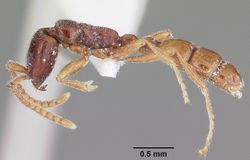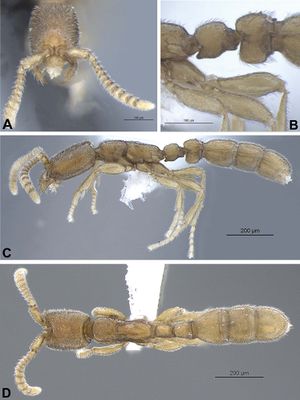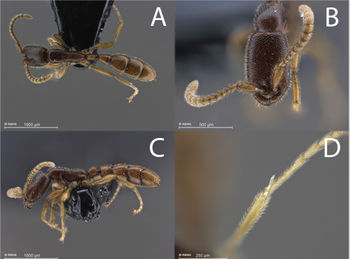Key to Leptanilloides species
This worker key is based on:
- Borowiec, M. L.; Longino, J. T. 2011. Three new species and reassessment of the rare Neotropical ant genus Leptanilloides (Hymenoptera, Formicidae, Leptanilloidinae). ZooKeys 133:19-48. [2011-10-05]
- Delsinne, T., Sonet, G. and Donoso, D.A. 2015. Two new species of Leptanilloides Mann, 1823 from the Andes of southern Ecuador. European Journal of Taxonomy. 143:1-35.
You may also be interested in
- Key to Asphinctanilloides workers (this small genus is synonymized under Leptanilloides Borowiec 2016)
- Leptanilloides
- Leptanilloides species groups
1
- Abdominal segment III (postpetiole) in lateral view much smaller than adjoining fourth abdominal segment (Figure 2A). Spiracle of segment III shift ed posteriad on anteromedian side of tergite (Figure 2A). Body size relatively large, HL 0.68–0.75 (legionarius species group) . . . . . 2
- Abdominal segment III (postpetiole) in lateral view nearly as high as abdominal segment IV (Figure 2B–D). Spiracle of segment III situated forward on the tergite (Figures 2B–D). Body size relatively small, HL 0.31–0.62 (biconstrictus species group) . . . . . 5
2
return to couplet #1
- Head subquadrate, CI 85–88; lateral margins nearly straight and parallel (Figure 2E). Propodeal declivity short and vertical, propodeum with dorsal and posterior faces clearly differentiated (Figure 2A) (Ecuador) . . . . . Leptanilloides nomadus
- Head subrectangular, CI 75–83; lateral margins convex (Figure 2F). Propodeal declivity usually rounded without clear distinction between dorsal and posterior face (cf. Figure 2B, Figure 4 in Donoso et al. 2006) . . . . . 3
3
return to couplet #2
- Head sculpture less dense, at most 10–12 shallow foveolae across face at midlength. Lateral margins of the head distinctly convex. Lateroclypeal tooth present. Posterior margin of the head slightly concave (Figure 2F) (Colombia) . . . . . Leptanilloides legionarius
- Head sculpture denser, with at least 15 foveolae across face at midlength. Lateral margin of head slightly convex. Lateroclypeal tooth absent. Posterior margin of the head deeply concave. (cf. Figure 2F, Figure 3 in Donoso et al. 2006 - head of L. nubelica) . . . . . 4
4
return to couplet #3
- Legs shorter, HW/HTiL×100 > 78. Hypostomal teeth present (Figure 2H) (Ecuador) . . . . . Leptanilloides nubecula
- Legs longer, HW/HTiL×100 < 78. Hypostomal teeth absent (Figure 2I) (Costa Rica) . . . . . Leptanilloides mckennae
5
return to couplet #1
- Lateroclypeal teeth absent. Masticatory margin of mandibles edentate (Ecuador) . . . . . Leptanilloides caracola
- Lateroclypeal teeth present. Masticatory margin of mandibles with teeth (Figure 4D), at least minute denticles present. . . . . . 6
6
return to couplet #5
- In lateral view, sternite of abdominal segment III (postpetiole) distinctly bulging anteriorly, making the sternal portion of the segment deeper than tergite (Figure 2D). Abdominal segment IV narrowly attached to the preceding segment III, and broadly to succeeding segment V, so that there is a contrast between widths of anterior and posterior articulation of the segment IV in lateral view (Colombia, Bolivia). . . . . 7
- In lateral view, sternite of abdominal segment III rather evenly rounded, and making the sternal and tergal portions subequal (Figures 2B, 2C). Abdominal segment IV relatively broadly attached to the preceding segment III, so that there is little contrast between widths of anterior and posterior articulations of segment IV in lateral view (Figures 4E, 5E) . . . . . 8
7
return to couplet #6
- In lateral view, sternite of abdominal segment III evenly rounded, making sternal and tergal portions subequal. Petiole as long as postpetiole. Reticulation on mesopleuron and metapleuron uninterrupted. Head densely foveolate, with c. 20–30 foveolae covering a straight transverse line at head midlength. HL ≤ 0.36 (Brazil) . . . . . Leptanilloides atlanticus
- In lateral view, sternite of abdominal segment III (postpetiole) distinctly bulging anteriorly, making sternal portion of segment deeper than tergite (Figure 2D). Petiole longer than postpetiole (Borowiec & Longino 2011: fig. 2d). Reticulation on mesopleuron and metapleuron superficial and interrupted. Head sculpture less dense, with only 10–20 foveolae covering a straight transverse line at head midlength. HL = 0.49 in only measured specimen (Bolivia, Colombia, Venezuela) . . . . . Leptanilloides biconstrictus
8
return to couplet #6
- In lateral view, petiolar sternite distinctly bulging medially (Figure 2C) . . . . . 9
- In lateral view, petiolar sternite straight (not bulging) or bulging anteriorly . . . . . 10
9
return to couplet #8
- Hind tibia with two very small, simple spurs, without pectinate spur clearly visible under 50x magnification (Figure 2J). Petiolar spiracle opening in an excavation distinctly larger than propodeal spiracle (Figure 5G, 5H). Flange over the metapleural gland opening sharply pointed posteriorly (Figure 5G) (Mexico, Guatemala) . . . . . Leptanilloides gracilis
- Hind tibia with a large pectinate spur, clearly discernable under 50x magnification. Petiolar spiracle not in excavation, similar and subequal to or smaller in diameter than propodeal spiracle (Figures 4G, 4H). Flange over metapleural gland opening rounded posteriorly (Figure 4G) (Venezuela) . . . . . Leptanilloides femoralis
10
return to couplet #8
- Head narrow, HL < 0.30, HW < 0.20, CI < 60. Head dorsum densely foveolate with foveolae separated by less than their diameter, often contiguous (Colombia) . . . . . Leptanilloides sculpturatus
- Head broader, HL > 0.30, HW > 0.20, CI > 65. Head dorsum less densely foveolate, with foveolae separated by about their diameter or more . . . . . 11
11
return to couplet #10
- Size large, HL ≥ 0.50, HW ≥ 0.38. Flange over metapleural gland opening short, not surpassing propodeum declivity margin in lateral view, and rounded posteriorly . . . . . 12
- Smaller, HL < 0.45, HW < 0.35. Flange over metapleural gland opening long, surpassing propodeum declivity margin in lateral view, and sharply pointed posteriorly . . . . . 13
12
return to couplet #11
- HL = 0.50 on single known specimen. Masticatory margin of mandible distinctly dentate, with regularly spaced and well-developed teeth (Brandão et al. 1999: fig. 16) (Ecuador) . . . . . Leptanilloides improvisus
- HL ≥ 0.58. Masticatory margin of mandible dentate but teeth extremely minute, blunt and irregularly shaped, difficult to discern even under magnifications of about 100× (Figs 4B, 6C) (Ecuador) . . . . . Leptanilloides prometeus
13
return to couplet #11
- Ventral margin of petiolar sternite forming an even convexity in lateral view. Reticulation on mesopleuron, metapleuron and lateral side of petiole uninterrupted. In dorsal view, petiole subquadrate, 67 ≤ PI ≤ 80 (Ecuador) . . . . . Leptanilloides erinys
- Ventral margin of petiolar sternite relatively straight in lateral view (Fig. 3C). Reticulation on mesopleuron, metapleuron and lateral side of petiole superficial and interrupted. In dorsal view, petiole slender, rectangular, 52 ≤ PI ≤ 63 (Fig. 3D) (Ecuador) . . . . . Leptanilloides copalinga




























